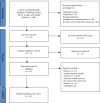Prevalence of Lumpy Skin Disease in Africa: A Systematic Review and Meta-Analysis from 2007 to 2023
- PMID: 38868352
- PMCID: PMC11168804
- DOI: 10.1155/2024/9991106
Prevalence of Lumpy Skin Disease in Africa: A Systematic Review and Meta-Analysis from 2007 to 2023
Abstract
Background: Lumpy skin disease (LSD) is an economically important, transboundary viral disease of cattle caused by LSD virus. This systematic review and meta-analysis are concerned with summarizing the status of lumpy skin disease in Africa.
Methods: Literature searches between 2007 and 2023 were conducted using different database searches: Google, Google Scholar, PubMed, and Science Direct, and then the required information were extracted. A random effect model was used to pool estimates of prevalence at 95% CI. Publication bias was assessed by applying funnel plots.
Results: The pooled estimated prevalence of LSD was 54% (95% CI: -0.09-1.18), with individual study prevalence ranging from 6 to 89%. Subgroup analysis showed that the random pooled prevalence of LSD was 28% (95% CI: -1.48-2.03) in Ethiopia, 37% (95% CI: -3.79-4.52) in Uganda, 88% (95% CI: -0.11-1.28) in Zimbabwe, and 58% (95% CI: -6.96-8.72) in Egypt. No single study was documented from western and northern Africa.
Conclusion: The estimated pooled LSD prevalence was investigated as high and indicated nonsignificant variation among study countries. Thus, vaccination of cattle, quarantine, and biting insect control should be applied to control the disease.
Copyright © 2024 Balemual Abebaw.
Conflict of interest statement
The author declares that there are no conflicts of interest associated with this manuscript.
Figures





Similar articles
-
Seroprevalence and risk factors for lumpy skin disease virus seropositivity in cattle in Uganda.BMC Vet Res. 2019 Jul 8;15(1):236. doi: 10.1186/s12917-019-1983-9. BMC Vet Res. 2019. PMID: 31286926 Free PMC article.
-
Spatial and temporal distribution of lumpy skin disease outbreaks in Uganda (2002-2016).BMC Vet Res. 2018 Jun 1;14(1):174. doi: 10.1186/s12917-018-1503-3. BMC Vet Res. 2018. PMID: 29859091 Free PMC article.
-
Field study on the use of vaccination to control the occurrence of lumpy skin disease in Ethiopian cattle.Prev Vet Med. 2017 Nov 1;147:34-41. doi: 10.1016/j.prevetmed.2017.08.019. Epub 2017 Oct 27. Prev Vet Med. 2017. PMID: 29254724
-
A review: Surveillance of lumpy skin disease (LSD) a growing problem in Asia.Microb Pathog. 2021 Sep;158:105050. doi: 10.1016/j.micpath.2021.105050. Epub 2021 Jun 17. Microb Pathog. 2021. PMID: 34146642 Review.
-
Epidemiology of bovine schistosomiasis and associated risk factors in Ethiopia: A systematic review with meta-analysis of published articles, 2008-2018.PLoS One. 2023 Jul 31;18(7):e0283691. doi: 10.1371/journal.pone.0283691. eCollection 2023. PLoS One. 2023. PMID: 37523370 Free PMC article.
Cited by
-
A systematic review of epidemiological modelling in response to lumpy skin disease outbreaks.Front Vet Sci. 2024 Sep 23;11:1459293. doi: 10.3389/fvets.2024.1459293. eCollection 2024. Front Vet Sci. 2024. PMID: 39376926 Free PMC article.
-
Pathogenicity and virulence of lumpy skin disease virus: A comprehensive update.Virulence. 2025 Dec;16(1):2495108. doi: 10.1080/21505594.2025.2495108. Epub 2025 Apr 27. Virulence. 2025. PMID: 40265421 Free PMC article. Review.
-
Characterization of Lumpy Skin Disease in Northern Bangladesh: Clinical, Pathological, Biochemical, and Molecular Perspectives.Vet Med Int. 2025 Jul 21;2025:4623554. doi: 10.1155/vmi/4623554. eCollection 2025. Vet Med Int. 2025. PMID: 40726513 Free PMC article.
-
Prevalence of lumpy skin disease and associated risk factors in beef cattle in Rembang Regency, Central Java, Indonesia.Vet World. 2025 Jan;18(1):76-84. doi: 10.14202/vetworld.2025.76-84. Epub 2025 Jan 14. Vet World. 2025. PMID: 40041517 Free PMC article.
References
-
- Abdallah F. M., Damaty H. M. El, Kotb G. F. Sporadic cases of lumpy skin disease among cattle in Sharkia province, Egypt: genetic characterization of lumpy skin disease virus isolates and pathological findings. Veterinary World . 2018;11(8):1150–1158. doi: 10.14202/vetworld.2018.1150-1158. - DOI - PMC - PubMed
-
- Ahmed E. M., Eltarabilli M. M., Shahein M. A., Fawzy M. Lumpy skin disease outbreaks investigation in Egyptian cattle and buffaloes: serological evidence and molecular characterization of genome termini. Comparative Immunology, Microbiology and Infectious Diseases . 2021;76 doi: 10.1016/j.cimid.2021.101639.101639 - DOI - PubMed
Publication types
LinkOut - more resources
Full Text Sources

